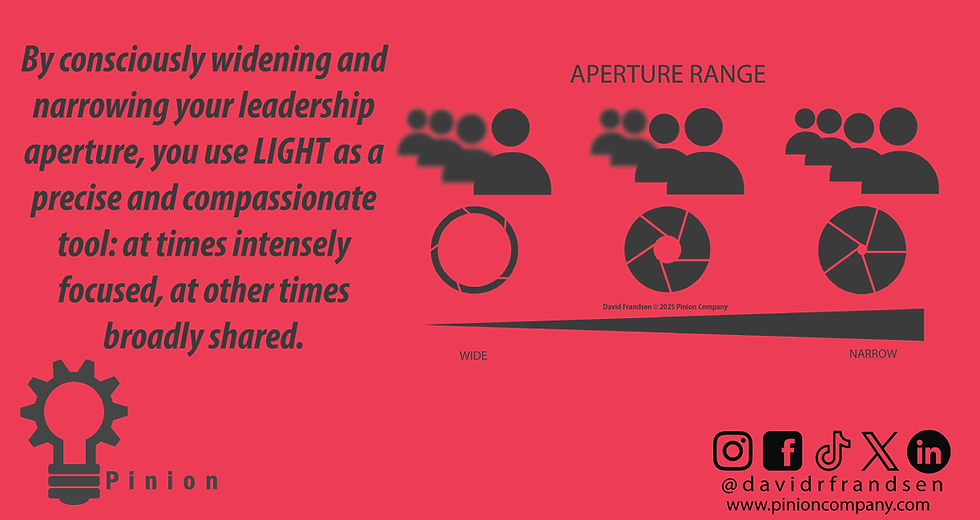Why Alignment, Not Total Agreement, Is What Cities Really Need
- David Frandsen
- Aug 11
- 3 min read

As anyone who’s spent time in city government knows, expecting total consensus on every issue is a losing game. Cities aren’t monoliths, they’re mosaics. Our residents come from countless backgrounds. Each department has their own priorities, perspective and working culture. It’s tempting to think that if we could just get everyone to see eye to eye, our jobs would be easier. But that’s not how vibrant cities work.
What actually matters isn’t universal agreement, it’s alignment.
The Myth of Total Agreement
Getting every department head, councilmember, or resident group to agree on the fundamentals is impossible. And frankly, the pursuit of total agreement can stifle the very energy cities need to solve big problems. Diversity of opinion, lived experience, and even outright disagreement help us find creative solutions and reflect the communities we serve. If we set our leadership north star to “no dissent,” we’ll only end up with watered-down policy and disengaged teams.
What Alignment Means for Running a City
For me, alignment is about shared purpose and coordinated progress. We don’t need uniformity of thought—we need unity of direction. When the public works crews, city managers, and council are all rowing toward the same outcomes—even if they get there by different routes—the city moves forward.
Think of city government like an orchestra. Our departments—public safety, public works, community development, engineering—are all different sections. Everyone brings their own sounds and skills. As city leaders, our job is to make sure we’re playing the same song, even if a little improvisation happens along the way.
What Alignment Looks Like in Practice
· Agreed-upon priorities—so when choices get tough (and they always do), people know which way to steer.
· Open communication and trust—enabling healthy debate, but also commitment to decisions once they’re made.
· Connecting daily work to overarching goals—building systems that work towards results.
· Room for disagreement, but a commitment to move forward together.
Don’t Confuse Alignment with Conformity
Alignment doesn’t mean we always agree. It doesn’t mean suppressing hard conversations or diverse perspectives. What it means is that, even after spirited debate, we’re committed to getting behind collective decisions, moving with a unity that puts city residents and progress first.
As I wrote in a previous article, Cohesion not Conformity, conformity is often more about the fear of not fitting in or the consequences of not doing what you are told. We want to build organization where people feel like they have the ability to stand up to something that feels wrong, and they are aligned with the others they are working with.
A lack of cohesion significantly contributes to our misalignment, and it usually stems from a lack of trust that trickles down, turns into conflict, a lack of productivity, and eventually turnover. Cohesion is developed through the elements of psychological attachment, interpersonal liking, group affiliation and trust.
Unity in Diversity: The City’s Real Strength
Our cities thrive when we harness the creativity, passion, and arguments of our people—but channel them toward shared outcomes. The art of running a city isn’t in forcing everyone into lockstep. It’s in a common direction so that, whatever detours or disagreements arise, the city moves forward—together.
Ultimately, alignment isn’t about getting everyone to sing the same note but ensuring we’re singing the same song. Cities will always be messy, dynamic, and full of differing opinions, that’s their great strength. Our job as city leaders is to create the clarity and trust that lets individuals and departments bring their best, even when they disagree, knowing we’re all working toward a shared future. When alignment and cohesion guide our actions—not forced agreement—we unlock the creativity and collective power needed to build cities that serve everyone.
#GearUpForSuccess #GearUp #GearUpYourOrganization #LeadershipDevelopment #Leadership #LeadershipSkills #LeadershipTraining #ProfessionalDevelopment #LeadershipCoaching #PersonalGrowth #CareerDevelopment #LeadershipQuotes #LeadershipGoals #Coaching #Entrepreneurship #Mindset #Success #PersonalDevelopment #BusinessStrategy #ProfessionalGrowth #LeadershipMatters #LeadershipLessons #Empowerment




Comments